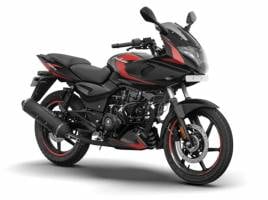2017 Maruti Suzuki Ignis first drive review
The "Millennials" as they like to call themselves, are a tough crowd to impress. I would know because, as much as I hate the term "Millennial", I'm one of them. While we grew up, the world was entering a new age -- a digital one. And things were changing very quickly thanks to the internet, computers and smartphones. With things going out of style as quickly as they came into style, we've always been keen on being up to date with everything in the market. If it's not the latest iPhone or the newest Android device, then it might as well be from the stone age. And if we like what we see, we are willing to spend a fair amount of money to have it.
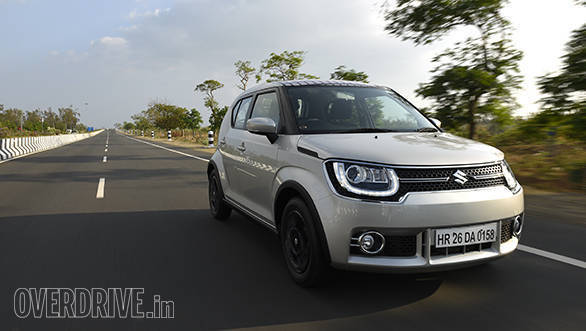
The same philosophy applies when it comes to picking a car -- it has to be as up to date as the latest iPhone, it should look fresher than a freshly baked bun, and it should be as practical as a middle-class Indian. So when Maruti Suzuki brought the Ignis name back from almost a decade ago, and said it was for the "Millennials", it had better have known what they were talking about it!
Design
Funky. That's the word I'd use to describe the Maruti Suzuki Ignis' design. Fresh, but also very funky. And funky is good! It sticks out of the hoard of conventional (cough boring cough) hatchbacks. I'm glad Suzuki's design approach, unlike most other manufacturers, isn't to make every car in the stable look like one another. It's really working in its favour. But I'll have to admit, I don't know what to call this one -- a crossover-ish, hatchback, mini SUV? Maruti is calling it a premium urban compact, whatever that is.
The design up front is very unconventional with the large grille stretching all the way to the fenders. On the extreme ends of the the grille are the floating headlamps (another fresh idea) which, even with just the halogen lights look quite good. That said DRLs and LED highlights do take that look one step further.
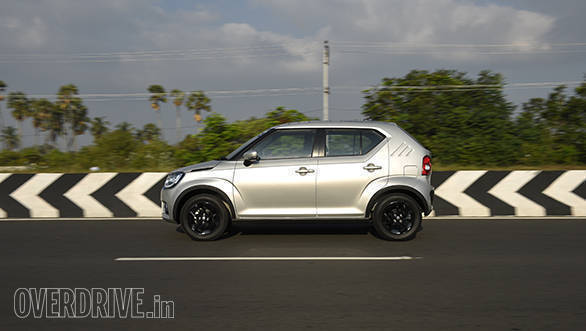
Move over to the side and you'll initially be taken aback a bit by the design. It might be a bit too quirky for some, but I like it! Again, there's nothing boring here right from the slits between the bonnet and the fender to the sharply pinched window line and the angled tailgate. The wheel arches are just a bit too flared, but it helps cover up the fact that the Ignis comes with relatively skinny 175/65 section tyres. But I think it's the sporty all-black 15-inch wheels, which almost look like a nice aftermarket fitment, that ties it together very well. Then there's the three slats that fill up the otherwise empty space between the window line and the tailgate. I especially like it because, as Bob pointed out, it is inspired by the Suzuki Cervo, a two-door coupe from the late 1970s.

Even at the rear, a few of the design cues, like the angled tailgate and the design of the tail light elements, are very similar to the Cervo. I know I said we like fresh designs, but I'm a bit old fashioned when it comes to cars, and so it really works for me. And, the rear of the car is just as quirky as the rest of it. The only issue I have here is with the plain black plastic cladding on the bumper. Internationally, this portion holds fog lights on either side of it, but India doesn't get them, which makes it quite plain in an otherwise fun rear end. I had also presumed that the angle of the tailgate would reduce rear visibility, but I was quite wrong.
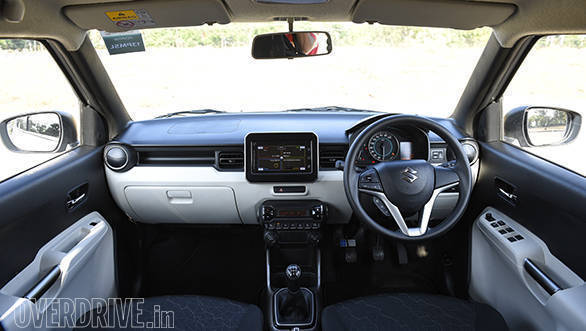
The first thing I noticed when I stepped inside the car was how good all-round visibility was. This is thanks to the high A-pillar, the large windows (it doesn't look so large from the outside) and the well designed rear window. The next thing I noticed was that Maruti Suzuki has finally used a new steering wheel! This one looks a lot sportier and far cooler than the plain overused wheel seen in almost every car in Maruti's current lineup. The rest of the interior is just as funky and as cleverly designed as the exterior with dual-tone finish on the dashboard, a floating AC console with toggle-like switches, carbon-fibre finishes around the AC vents and the tablet-like touchscreen system. Then there's the body-coloured panels inside like on the door handles, and the portion surrounding the gearbox. In some colours this looks nice, but in others, like the bright red one, it's a bit too tacky for me. Plastic quality looks and feels quite decent, like in the Baleno, but isn't the best in the market. The Zeta variant, which is the one below the top-spec Alpha, doesn't get automatic climate control or a touchscreen infotainment system. While the design of the two-DIN audio system and the manual AC controls don't look as appealing, it still is quite neat.


What's most impressive is the amount of space inside the car... for four people, that is. The seats -- especially up front -- are very comfortable with good bolstering, while there's a good amount of knee room and head room at the back. Despite having a similar wheelbase to the current Swift, knee room appears to be better. However, rear shoulder room is quite poor and can seat just two adults comfortably. Another issue was that the rear door opening wasn't high enough, making ingress and egress a bit inconvenient. The boot on the other hand which has a capacity of 260l, isn't as spacious as the Baleno's 339l, but is better than the the Swift's 204l.
Engine and performance
The Maruti Suzuki Ignis will be offered with engines that we in India are all too familiar with -- the 83PS/113Nm 1.2-litre petrol, and the 75PS/190Nm 1.3-litre turbodiesel Multijet. Both come with 5-speed manual and AMT options. After I had driven the diesel Swift Dzire with an AMT, I had higher hopes for the diesel Ignis than the petrol. The gearbox seemed to work very well with the engine's character and I expected it to work better with it than with the petrol unit. But my presumptions were quite wrong.
I drove the diesel first and immediately, I felt quite uncomfortable with the way the AMT was working. Gear shifts weren't very predictable and it seemed like it was doing its own thing rather than doing what I wanted it to. And for some reason, the revs wouldn't drop as soon as you lifted your foot off the accelerator. It would stay at the rpm you left it at for an extra second, which means it doesn't start decelerating immediately. That's quite unnerving especially while driving it within city where there's constant acceleration and deceleration thanks to traffic.
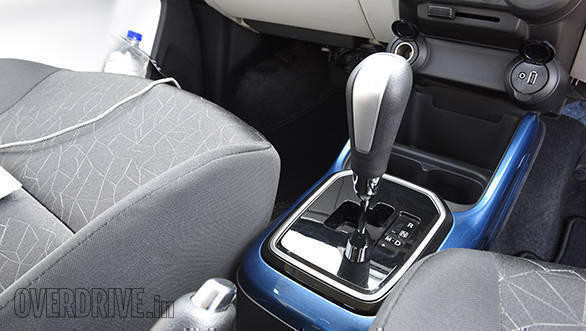
In comparison, the petrol AMT seemed to work much better and I felt right at home driving it. Gearshifts, although not as seamless or as quick as in a torque converter, were predictable and quick by AMT standards. It felt more in sync with the engine and was doing just what I wanted it to do. Downshifts were offered without hesitation as soon as I jabbed the throttle, and when I lifted off for an upshift, it would immediately obey. It doesn't hold on to a gear for too long if you're not accelerating hard, but it's not expected to either. If you want that, you'll have to switch to manual mode which, in both diesel and petrol variants, work very well. But the more I drove the petrol AMT, the happier I was that Maruti decided to ditch the CVT unit from the Baleno.
The 5-speed manual gearbox is great in the petrol and diesel variants, and is my pick if you're inclined more towards fun than convenience. Gearshifts are quite slick and they slot into place precisely with a very pleasing 'click-click' action just like in most of the other Marutis. The clutch meanwhile is light and progressive, making it quite easy to manage in the city.
When it comes to picking between the diesel and petrol engines, I'm a bit partial towards the latter, and I'll explain why. The diesel engine, despite being a bit rough and slow-revving, still packs a good punch. There is that familiar lag till around 1,700rpm, but once the turbo spools up, the rpm meter quickly climbs up till the redline. NVH levels are good too, but from our experience with our long term Baleno, the diesel engine does get a bit noisier with age. But it's still a proven engine, and it's that sense of reliability that makes it a Maruti.

The petrol engine, which has proven to be just as reliable, is very refined and you can't tell if it's running while at idle. The free-revving engine has a strong top-end, with well configured gear ratios that won't leave you bogged down at any point. The engine is very quiet till just under 3,000rpm, after which the engine note turns into a crisp and raspy note that only encourages you to take it all the way to the redline. It makes you feel like you're in a baby rallycar of sorts, and to me it suits the entire character of the car far more than the slow-revving diesel engine. And this car is all about character!
The diesel engine would be great on the highways with its strong mid-range and is more efficient too with Maruti claiming 26.8kmpl. But how often are you going to take this car on highway? For a daily drive through the city, the petrol is far more enjoyable. And Maruti is claiming it'll return 20.89kmpl per litre, which is still quite good. But only a road test will reveal real world figures.
Ride and handling
The Ignis' suspension setup is a bit on the firmer side. Small potholes and undulations are absorbed well, but the sharper ones will result in a few thuds. If you don't slow down over the larger ruts, the slightly taut damping can get a bit uncomfortable like in the Baleno. But as a result of this, handling is not bad at all.
The car feels very nimble and it changes direction pretty quickly. This along with its compact dimensions, makes it a real riot to drive inside the city. We didn't get to thoroughly test how well it handles corners at higher speeds thanks to the almost straight route we followed on the East Coast Road in Chennai. But from what we could tell, there is some amount of well-controlled body roll during quick direction changes at high speeds. We'll have to wait till the road test to find out just how good it is around the twisties. High speed stability however, is very impressive especially considering the skinny tyres it's running, while the brakes, which are progressive in nature, offer good performance and feedback.
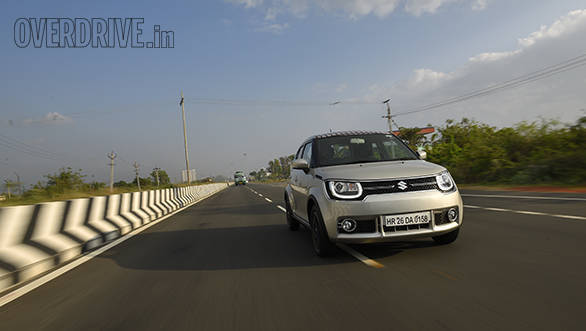
Where it does fall short though, is with the steering. The electric steering in the Ignis is quite lifeless, and is probably the weakest link when it comes to being connected to the driver. It takes a while before you get used to the vague feel of the steering. It doesn't weigh up very well at high speeds either, making sudden direction changes a bit unnerving. That said, its light weight makes it very convenient to use in the city, which is where this car will mostly be driven.
Safety and features
In terms of safety the Ignis comes with ABS, dual front airbags and ISOFIX seat anchorages as standard features across the range. So full points to Maruti for that! However, it does miss out on a bunch of safety features offered in the Euro-spec car like four more airbags and the dual camera brake support system. This system uses two cameras to detect objects in front of the car and applies the brake automatically in case of an emergency.
With respect to creature comforts, the top-end Alpha variant comes with a decent amount of kit like the segment-first LED headlamps with DRLs, automatic climate control, keyless ignition and the touchscreen infotainment system which now supports Android Auto and Apple CarPlay. Unfortunately, the AMT won't be available in this variant. It will be an option on the Zeta variant and the one below that, called Delta.
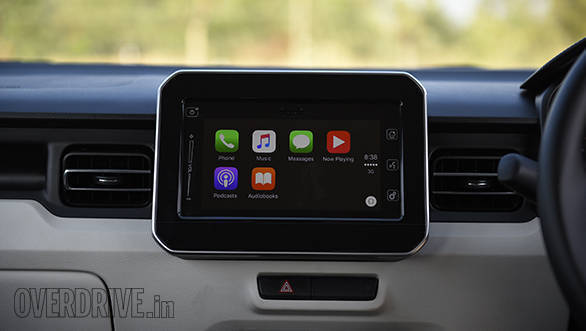 The top-spec Alpha trim gets a tablet-like touchscreen infotainment system
The top-spec Alpha trim gets a tablet-like touchscreen infotainment system
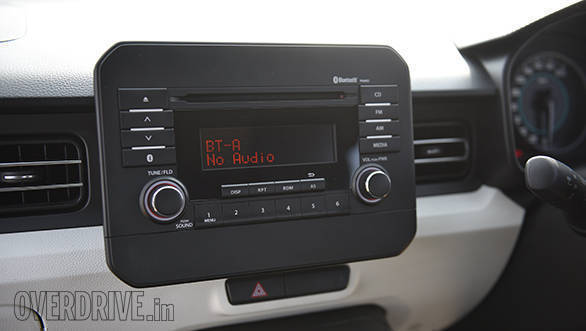 Maruti has done a decent job of fitting the double-DIN system in the Zeta variant
Maruti has done a decent job of fitting the double-DIN system in the Zeta variant
But what I particularly like about this car is the long list of accessories and personalisation options available for the car. Some are really cool, and some, not so much.
Verdict
I really like the Ignis. It's one of the few cars in the affordable segment that has character. It's a fun little car in every way, and there hasn't been a car so far in the sub-10 lakh price range that's put a mischievous smile on my face the way this one did. In fact, it's one of the few cars in this price bracket that I really, really want to own. Then of course, the price comes in, and I'm forced to sink back in my seat.
The top-spec petrol variant with a manual transmission, which is the one I'd buy, costs Rs 6.69 lakh, ex-showroom Delhi. It's quite steep especially when you consider that the top-spec Baleno petrol costs just Rs 50,000 more and offers the same amount of kit and also more room. It's a similar story with the top-end diesel variant as well, which costs Rs 7.80 lakh.
The petrol Zeta variant with the AMT costs around Rs 40,000 less than the top-spec manual. And it's only in this respect that the Ignis makes more sense, as the Baleno CVT costs around Rs 1,30,000 more. But if you're willing to make a compromise on creature comforts like climate control and a touchscreen infotainment system for the fun of a manual gearbox, the petrol Zeta variant, which costs Rs 5.75 lakh, is something I'd recommend. It's still a bit expensive, but like I said, we're a generation that won't hesitate to spend a fair amount of money if we like what we see. And I like it!
More from OVERDRIVE on the Maruti Suzuki Ignis:
Maruti Suzuki Ignis accessories detailed
Spec comparison: Maruti Suzuki Ignis vs Mahindra KUV100 vs Renault Kwid vs Maruti Vitara Brezza
Maruti Suzuki Ignis variants explained
Maruti Suzuki Ignis will be available in nine colours
Starts Rs 4.89 Lakhs
1197cc
Automatic
82.93
113
20.89 Kmpl
Starts Rs 2.62 Lakhs
999cc
Automatic
68
91
-NA-







